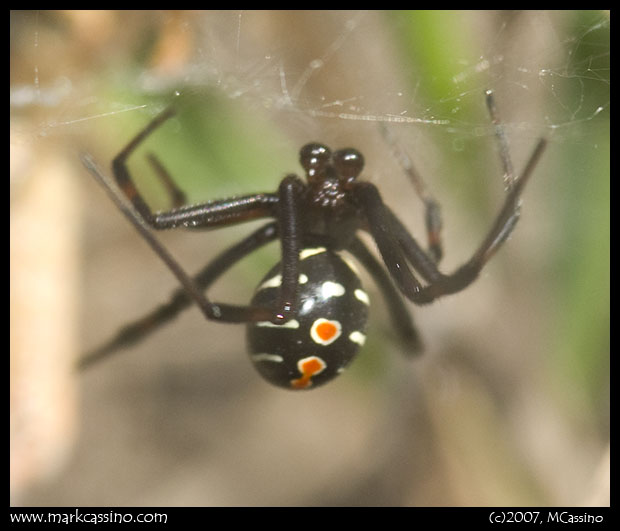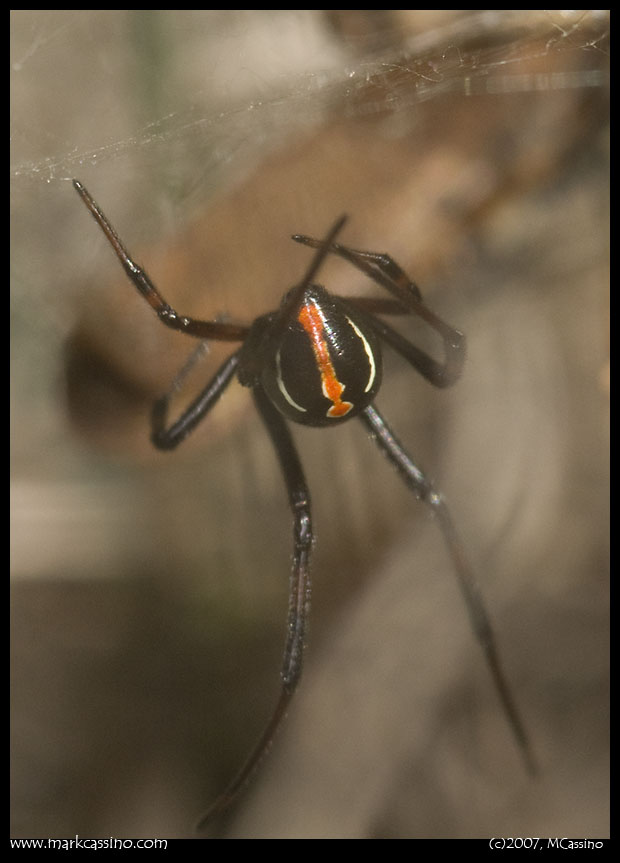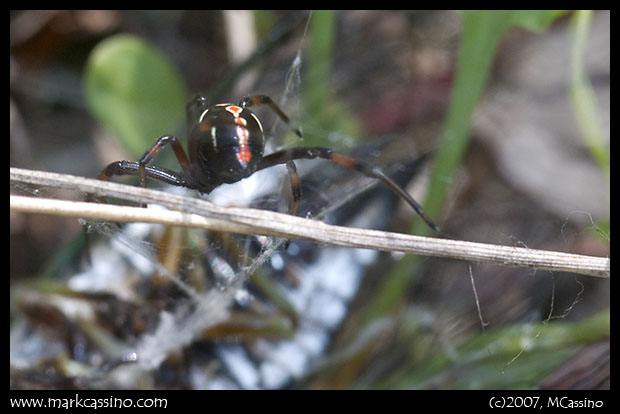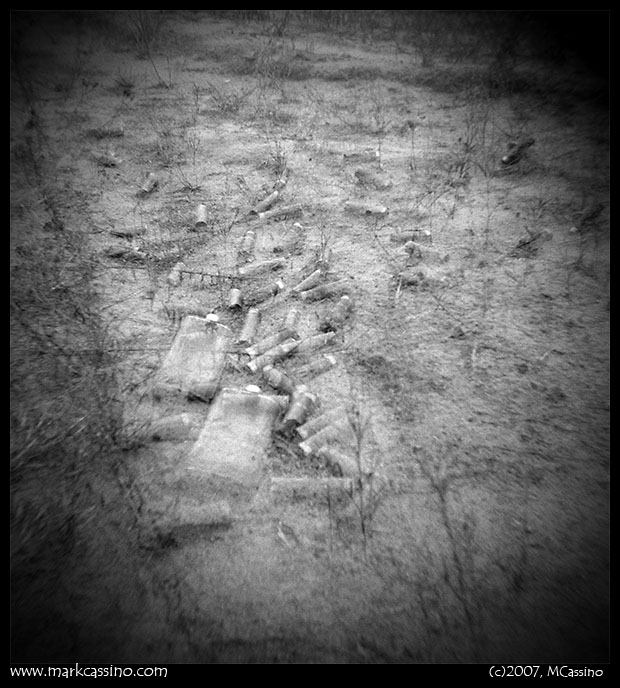
A few days ago I commented on observing a black and red spider, overcoming a grasshopper many times its size. Based on the size and shape of the spider, I wondered if it was a Black Widow – but I dismissed that idea because it had yellow bands in addition to red markings, and also because the red markings did not form the hourglass shape that we associate with Black Widows.
A week later I again encountered one of these shiny black spiders – this time with a dead cicada in its web. I decided it was time to identify this species.
When I turned to my field guides and attempted to identify this spider, I got a bit of a surprise. While it’s not a Black Widow, it turns out that the Black Widow has a northern cousin – know as the Northern Black Spider or Northern Black Widow Spider. In fact – there are several varieties of widow spiders, apparently with similar degrees of toxicity. On the plus side – most of the material I’ve read indicates that deaths from these spiders are very rare. Some sources put the odds of fatality at only 1%.
Bugguide.net has a nice collection of photos of the northern widow.
The Southern Black Widow (the only black widow I was aware of until recently) is Latrodectus mactan. The Northern Black Spider is Latrodectus various.) This site, from the US army – has a rundown of all North American widow species - http:chppm-www.apgea.army.mil/ento/FACTS/WidowSpiderJTF-Mar2006.pdf)
 It was interesting to actually observe these spiders in action. I had always wondered why these spiders had such intensely strong venom, and figured that it was just an example of randomness in evolution. After all – a spider simply has to have venom strong enough to kill prey. There is no downside to having venom far more powerful than the minimum needed, so if a species happened to evolve with super-potent venom, there would be no evolutionary pressure to move towards a weaker poison. The species would continue with venom stronger than needed, simply because it works.
It was interesting to actually observe these spiders in action. I had always wondered why these spiders had such intensely strong venom, and figured that it was just an example of randomness in evolution. After all – a spider simply has to have venom strong enough to kill prey. There is no downside to having venom far more powerful than the minimum needed, so if a species happened to evolve with super-potent venom, there would be no evolutionary pressure to move towards a weaker poison. The species would continue with venom stronger than needed, simply because it works.
While one can’t draw a conclusion from just two observations – I now look at things differently. Both of these spiders were subduing relatively enormous prey. Their webs were disorganized strands of silk in the grass, but were also quite strong. Strong enough to hold a large grasshopper and cicada long enough for the potent venom to take hold.
So maybe the great toxicity of these spiders’ venom is part and parcel of a much more complicated – and very specific – survival strategy. Grab large prey and subdue it fast. It would be interesting to survey a population of these spiders in the wild, and see if they rely on large prey vs. smaller insects for food.
At any rate – I’m now pretty convinced that these spiders are common in some parts of the Allegan Forest. My two sightings were a week apart, but also several miles apart – the first one was in the site I call the coreopsis field, which is a clearing off 46th street, just about 1 mile north of 118th avenue. The second sighting was in the old farmstead, off 48th street and about a mile south of 115th avenue.
Now that I know what the webs look like – I’m quite certain that I’ve seen several in the past few months. I can think of at least two occasions where I’ve seen large insects – once a butterfly and the other a grasshopper – trapped in similar webs in the field off 48th street.
 Since I first observed these spiders while lying on the ground, shooting low perching dragon flies, their presence in the fields is a little bit of a concern. While these spiders only bite as a last resort – I can easily see myself laying a bare arm on top of one while lining up a shot of a dragonfly, bee, or butterfly.
Since I first observed these spiders while lying on the ground, shooting low perching dragon flies, their presence in the fields is a little bit of a concern. While these spiders only bite as a last resort – I can easily see myself laying a bare arm on top of one while lining up a shot of a dragonfly, bee, or butterfly.
I guess I should be worried – but then the odds of getting into a car accident while driving from Kalamazoo to Allegan are probably greater than the odds of being bitten by a Northern Black Widow – and certainly higher than the odds of being fatally bitten.
At least now I know what to watch for, and if abdominal cramps and other symptoms settle in after a day’s shooting, I’ll know to get to the doctor as opposed to just waiting it out. And here again – the Allegan Forest has produced another interesting subject, and getting some good, clear shots of these spiders (unlike the ones shown here) will be a future project.










 The Signature Artists Cooperative is a great bunch of artists from all fields, who meet throughout the year to exchange ideas, critique each other’s work, and just have fun. We also run an itinerant gallery in the Kalamazoo area - popping up in some vacant storefront for the month of December.
The Signature Artists Cooperative is a great bunch of artists from all fields, who meet throughout the year to exchange ideas, critique each other’s work, and just have fun. We also run an itinerant gallery in the Kalamazoo area - popping up in some vacant storefront for the month of December.
 It was interesting to actually observe these spiders in action. I had always wondered why these spiders had such intensely strong venom, and figured that it was just an example of randomness in evolution. After all – a spider simply has to have venom strong enough to kill prey. There is no downside to having venom far more powerful than the minimum needed, so if a species happened to evolve with super-potent venom, there would be no evolutionary pressure to move towards a weaker poison. The species would continue with venom stronger than needed, simply because it works.
It was interesting to actually observe these spiders in action. I had always wondered why these spiders had such intensely strong venom, and figured that it was just an example of randomness in evolution. After all – a spider simply has to have venom strong enough to kill prey. There is no downside to having venom far more powerful than the minimum needed, so if a species happened to evolve with super-potent venom, there would be no evolutionary pressure to move towards a weaker poison. The species would continue with venom stronger than needed, simply because it works.  Since I first observed these spiders while lying on the ground, shooting low perching dragon flies, their presence in the fields is a little bit of a concern. While these spiders only bite as a last resort – I can easily see myself laying a bare arm on top of one while lining up a shot of a dragonfly, bee, or butterfly.
Since I first observed these spiders while lying on the ground, shooting low perching dragon flies, their presence in the fields is a little bit of a concern. While these spiders only bite as a last resort – I can easily see myself laying a bare arm on top of one while lining up a shot of a dragonfly, bee, or butterfly. 










